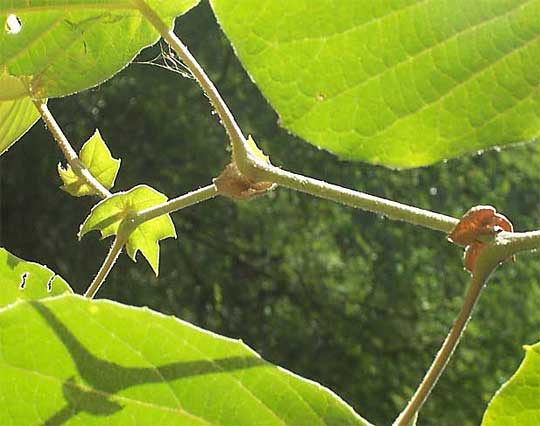Excerpts from Jim Conrad's
Naturalist Newsletter
from the December 11, 2006 Newsletter issued from Sierra Gorda Biosphere Reserve, QUERÉTARO, MÉXICO
MEXICAN SYCAMORES
One of my tasks at the Biosphere Reserve is to visit all the region's ecotouristic destinations and take notes and pictures. I don't get paid for it but I'm given a place to stay and I like doing it. Last Monday I was taken to the Río Escalones where a tiny community of campesinos hopes to entice visitors to use its picnic area set along a pretty little stream, and take a guided hike to see where the stream runs beneath a natural stone bridge. You can see the Río Escalones cascading among boulders below:

Things in that picture may look awfully familiar to you, especially because leaning out over the stream are large trees looking very much like the sycamores we have in North America. They are indeed sycamores but not our North American ones. The gringo trees are American Sycamores, Platanus occidentalis, while the ones in the picture are Mexican Sycamores, Platanus mexicana.
Right now our Mexican Sycamores still bear green leaves but the leaves are turning brown and starting to fall. It's curious that this species who doesn't have to worry about water or even frosts is losing its leaves. Maybe losing the leaves is a vestigial, genetically fixed trait inherited from a northern or Ice-Age ancestor who lost leaves during cold winters, or maybe it's a way of ridding the trees of insect- and fungus-infected leaves and starting all over with healthy new ones.
Though the Mexican and American Sycamores are a lot alike you can see in the picture that the Mexican species tends to produce a massive trunk base that soon splits into smaller two to several smaller trunks. I read that here the species flowers from December to February, then the fruits mature from April to August.
In Spanish this tree is called "Álamo." Our English name "sycamore" is a pretty word. One interpretation of that name's etymology is that it came into English around 1350 from the Old French "sicamor," which derived from the Latin "sycomorus," which came from the Greek "sykomoros," which was based on "sykon," which means "fig," and "moron," which means "mulberry." Well, sycamore leaves are a little similar to mulberry leaves, if you think about it. Other ideas about the origin of "sycamore" are at http://www.etymonline.com/index.php?term=sycamore.
Sycamores are often called "plane trees." The word "plane" passed through various languages from the old Greek "platanistos," the "plata" part associated with "platys," which means "broad," referring to the tree's large, wide leaves.
Mexican Sycamores are native to northeastern and central Mexico. Mexico also is home to the Chiapas and Oaxaca Sycamores in the south, Gentry's Sycamore in the west, Rzedowski's Sycamore in the east and the Arizona Sycamore in the northwest. On the whole planet only about ten sycamore species are recognized so a good bet is that the first primitive sycamores arose in Mexico. Sycamore species also occur in Asia and Europe. It's interesting that when European species are crossed with American ones fertile hybrids are produced.
from the June 2, 2007 Newsletter issued from Sierra Gorda Biosphere Reserve, QUERÉTARO, MÉXICO
SYCAMORE STIPULES
Beginning botany students often find it hard to understand about "stipules." A typical definition of a stipule is that it's "a small leafy outgrowth at the base of a leaf or its petiole (leaf-stalk); usually stipules occur in pairs and are soon shed." A botanist might need the further qualification that a stipule is to be understood as a basal appendage of a leaf's petiole, the three parts of a complete leaf being the blade, petiole and the stipules.
The Mexican Sycamore shading my tent last weekend had very prominent stipules, as do all sycamores. You can see them surrounding the tree's leaf-petiole bases below:

In that picture, notice how stipules below the newest leaves are fresh and green but those subtending the oldest leaves already are turning brown. Eventually they'll fall off leaving a "stipular ring," or scar, encircling the stem. Stipule scars can be very helpful identifying twigs during the winter. Often the scars appear on twigs as tiny slits at the tops of leafscars. Usually you don't see them unless you're looking for them.
Probably stipules occur in less than a quarter of all flowering-plant families, so, when you're trying to determine what family an unknown plant belongs to, checking to see if it has stipules or stiplule scars is a good idea.
In those plant families with stipules, the stipules behave in various ways. Non-green stipules quickly falling off before a leaf finishes expanding may have no real purpose, and can be regarded as evolutionary vestiges. Other times, as with our sycamore, stipules are large and green, helping photosynthesize food during the critical leaf-expanding process. Sometimes stipules harden and become spines at the bases of petioles, as with Blacklocusts. Among the greenbriars, stipules have evolved into tendrils. Desert-living Creosote Bushes bear corky stipules but it's not clear what they do. Some stipules develop glands providing nectar for ants, who defend the plant from herbivores.
Especially if you have a handlens, you might enjoy looking for stipules or their scars. They form a whole arena of interest all by themselves.